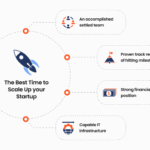What impact does the choice of funding have on long-term business strategy?
You’ve got a brilliant business idea, the passion is burning bright, and you can almost taste success. But then comes the crucial question: how do you fund it? Many entrepreneurs in India focus solely on securing the capital, thinking that’s the biggest hurdle. However, getting the funds is just the start. The type of funding you choose has a profound and lasting impact on business strategy, shaping everything from your day-to-day operations to your ultimate exit plan. Understanding this connection before you start pitching investors or signing loan documents is critical for setting your business on the right path. For small business owners and aspiring entrepreneurs across India, grasping how different business strategy funding options India influence your company’s future is essential for long-term success. This post will explore common funding types available in India and delve into how each choice significantly dictates your strategic direction.
Understanding Key Funding Options for Indian Businesses
Before analysing the strategic implications, let’s quickly define the common funding avenues available to businesses in India. Each comes with its own set of immediate characteristics, advantages, and disadvantages.
Bootstrapping: Building on Your Own Terms
Bootstrapping means building your company from the ground up using personal savings, initial revenue generated by the business itself (retained earnings), or very minimal external help. It’s about being resourceful and making do with what you have.
Pros: The biggest advantage is complete control. You answer to no one but yourself and your customers. There’s no equity dilution, meaning you own 100% of your company. This often forces lean operations and a focus on profitability from day one.
Cons: Growth can be significantly slower compared to funded competitors. You bear considerable personal financial risk. Scaling the business rapidly might be challenging due to limited resources.
Strategic Implication Teaser: This path naturally leads to a business strategy centred around careful organic growth, meticulous cash flow management, and achieving profitability early on. For more information on effective business planning and structuring, refer to Company Registration in India.
Angel Investors: Smart Money & Mentorship
Angel investors are typically high-net-worth individuals who invest their personal funds into early-stage businesses, often in sectors they understand well. They usually seek equity in return.
Pros: Beyond just capital, Angels often bring valuable industry expertise, crucial network access (potential clients, partners, future investors), and mentorship. This is often termed “smart money”.
Cons: You will have to give up a portion of your company (equity dilution). There’s always the potential for founder-investor disagreements on strategy or operations. You inevitably lose some degree of control.
Strategic Implication Teaser: Accepting Angel investment often signals a strategic shift towards accelerating growth, leveraging the investor’s connections, and potentially preparing for larger funding rounds. Understanding the effects of funding on business strategy for Indian entrepreneurs is key here, as Angels can actively shape direction.
Venture Capital (VC): Fueling Rapid Expansion
Venture Capital firms are institutional investors managing pooled money from various sources (pension funds, endowments, etc.). They invest significant capital into startups perceived to have extremely high growth potential, demanding substantial equity and often a board seat in return.
Pros: VCs provide large capital injections enabling rapid scaling. They offer support structures for scalability, lend significant credibility to the startup, and provide structured guidance through board participation.
Cons: This comes at the cost of significant equity dilution and loss of substantial control. There’s immense pressure for rapid growth and a defined exit (like an IPO or acquisition). Expect rigorous reporting requirements and oversight.
Strategic Implication Teaser: VC funding fundamentally dictates an aggressive growth strategy. The need to provide large returns within a typical fund lifecycle (5-7 years) means the funding choices impact on long-term business strategy India is profound, often pre-defining exit expectations and prioritising market share capture over immediate profitability.
Debt Financing: Loans and Lines of Credit
Debt financing involves borrowing money that must be repaid over an agreed period, with interest. Common sources in India include banks, Non-Banking Financial Companies (NBFCs), and lines of credit.
Pros: The primary benefit is retaining full ownership and control of your company, provided you meet the loan terms (covenants). Interest payments are usually tax-deductible, reducing the effective cost of the loan.
Cons: There’s a strict repayment obligation, regardless of whether your business is profitable. Lenders often require collateral (personal or business assets). Interest costs can add up, impacting cash flow. Restrictive loan covenants might limit certain business actions (e.g., taking on more debt, selling assets).
Strategic Implication Teaser: Relying on debt requires a strategic focus on generating consistent, predictable cash flow and maintaining profitability to comfortably service the debt obligations.
Government Schemes & Grants: Leveraging Public Support
The Indian government, at both central and state levels, offers various schemes and grants to support entrepreneurs and small businesses. Examples include the Startup India Seed Fund Scheme, Pradhan Mantri MUDRA Yojana (PMMY) for micro-units, and numerous sector-specific subsidies or grants.
Pros: Grants are often non-dilutive (you don’t give up equity). Loans under these schemes might come with subsidized interest rates or relaxed collateral requirements. Government backing can also add credibility.
Cons: Eligibility criteria can be strict and specific. The application processes are often lengthy and bureaucratic. Funds usually come with specific usage restrictions. There are ongoing compliance and reporting requirements.
Strategic Implication Teaser: Utilising government schemes often means aligning your business strategy partially with national or state objectives (e.g., job creation, innovation in specific sectors) and necessitates robust compliance systems. For detailed insights on navigating compliance, consider our Taxation Services in India.
How Funding Choices Dictate Your Long-Term Business Strategy
Securing funding is a major milestone, but it’s crucial to recognise that the source of that funding inherently shapes your company’s future. The impact on business strategy is significant and multifaceted, influencing everything from autonomy to operational speed. Let’s explore these connections.
Control vs. Growth: The Fundamental Trade-Off
One of the most immediate strategic implications of your funding choice revolves around the balance between maintaining control and pursuing rapid growth. Bootstrapping and, to a large extent, debt financing allow founders to retain complete ownership and decision-making authority. However, this often comes at the cost of slower growth due to limited capital for expansion, marketing, or R&D. Conversely, equity financing through Angel investors or VCs provides the fuel for accelerated growth but requires founders to relinquish significant ownership and control. This fundamental impact of funding choice on business strategy in India dictates crucial decisions: Are you aiming for quick market domination, necessitating external equity, or are you comfortable with slower, more controlled organic growth? This influences your market entry speed, how quickly you can launch new products or features, and the pace at which you can build your team. A bootstrapped company might focus on perfecting a niche product for profitability, while a VC-backed firm might aggressively pursue market share across multiple verticals simultaneously.
Shaping Strategic Direction and Decision-Making
Beyond ownership, the type of funding directly influences who has a say in major strategic decisions. Bootstrapped founders have complete autonomy. Those using debt financing maintain control as long as they meet their repayment obligations and loan covenants, which might restrict certain financial actions but usually don’t dictate core business strategy. However, bringing Angel investors or VCs on board changes the dynamic significantly. Active Angels often provide valuable advice, but they also have expectations tied to their investment. VCs, typically taking board seats, have formal power to influence critical decisions. Their focus on maximizing returns within a specific timeframe means their perspective might prioritise rapid scaling and exit potential over a founder’s original long-term vision or preferred operational style. Examples include pressure to pivot the business model towards a larger perceived market, push for aggressive expansion into new geographies even if operationally challenging, vetoing or pushing for certain key hires based on investor networks, or prioritising product features that enhance valuation over immediate customer requests. The strategy becomes a negotiated outcome rather than a purely founder-driven vision.
Exit Strategy Implications
Your funding source heavily signals, and sometimes dictates, your potential exit strategy. Venture capital firms invest with the explicit expectation of a high-return exit within a defined period (typically 5-10 years). Their entire model depends on it. Therefore, accepting VC money inherently aligns your long-term strategy towards achieving an exit event like an Initial Public Offering (IPO) or a high-value acquisition by a larger company. Strategic decisions will be evaluated based on how well they position the company for such an exit. Bootstrapped businesses, or those primarily using debt, have far more flexibility. The founder can choose to run the company as a long-term profitable “lifestyle business,” plan for succession within the family or management team, or sell on their own terms and timeline without external investor pressure. Angel investors often fall somewhere in between; they seek a return but might be more flexible on the timeline than VCs. Understanding these funding choices impact on long-term business strategy India related to exits is crucial from the outset. If your dream is to build a legacy business to pass on, VC funding might be strategically misaligned.
Operational Tempo and Resource Allocation
The amount and type of funding received directly impact the pace and nature of your day-to-day operations and how resources are allocated. A heavily funded VC-backed startup operates at a fundamentally different tempo than a bootstrapped one. With significant capital, the VC-backed company can afford larger hiring budgets to attract top-tier talent quickly, implement aggressive marketing campaigns to capture market share rapidly, and invest heavily in Research & Development (R&D) to out-innovate competitors. Their strategy often embraces higher risk tolerance in operations, experimenting with new initiatives backed by ample funding. Conversely, a bootstrapped or debt-financed business typically operates more cautiously. Hiring might be slower and more deliberate, marketing often relies on organic growth and cost-effective channels, and R&D might be more incremental. Resource allocation is tightly controlled, focusing on immediate ROI and cash flow preservation. This funding impact on business strategy in India shapes the company culture, operational efficiency focus, and overall ability to respond to market opportunities or threats with speed and scale.
Aligning Funding with Your Business Goals in India
Choosing the right funding path isn’t just about finding willing investors or lenders; it’s about making a strategic decision that aligns with your specific vision, needs, and risk appetite. Here’s how Indian entrepreneurs can approach this critical choice:
Assess Your Business Needs & Growth Ambitions
Before you even think about pitching or applying for loans, take a hard look at your business and your personal goals. Ask yourself:
- How much capital do I really need? Be realistic. Over-funding can lead to wasteful spending, while under-funding cripples growth. Create detailed financial projections.
- What is my desired growth trajectory? Do you envision slow, steady, profitable growth (suggesting bootstrapping or debt might suffice), or are you aiming for rapid market capture and scaling (often requiring equity investment)?
- How much control am I willing to give up? Be honest about your comfort level with sharing decision-making power and ownership. This is a primary differentiator between debt/bootstrapping and equity.
- What is my tolerance for debt repayment pressure? Can your business model reliably generate the cash flow needed to service debt, even during lean periods? Assess the risk involved.
Conduct Due Diligence on Funding Sources
Don’t just focus on the amount of money offered. Look beyond the cheque:
- Research potential investors: For Angels and VCs, investigate their track record, areas of expertise, typical investment size, and the value they bring beyond capital (networks, mentorship). Talk to other founders they’ve funded. Ensure their investment philosophy aligns with your vision.
- Understand the terms: Scrutinize term sheets and loan agreements. For equity, pay close attention to valuation, equity percentage, control clauses (board seats, veto rights), liquidation preferences, and reporting requirements.
- Compare loan options: For debt, compare interest rates (fixed vs. variable), repayment schedules, collateral requirements, processing fees, and any restrictive covenants. Explore options from banks, NBFCs, and government schemes.
Consider the Legal & Compliance Structure (TaxRobo Relevance)
Securing funding isn’t the end of the paperwork; it’s often just the beginning. Getting the structure right from the start is crucial and has long-term implications:
- Proper Documentation: Ensure all funding deals are legally sound. This includes well-drafted shareholder agreements for equity investments, defining rights and responsibilities, and clear loan agreements specifying all terms and conditions. For more assistance on securing funding without losing control, you can explore our guide on How do I secure funding for my startup without losing control of my company?
- Post-Funding Compliance: Be prepared for ongoing compliance requirements. This involves regular filings with the Registrar of Companies (ROC), maintaining proper books of accounts, adhering to specific investor reporting schedules, and managing tax implications (like GST on expenses, TDS, Income Tax on profits, and potential implications of foreign investment under FEMA).
- Expert Guidance: Navigating the complexities of funding structures, legal documentation, and ongoing financial and tax compliance can be overwhelming. Engaging professional advisors early on is highly recommended. TaxRobo offers expert services in areas like business planning and structuring, company registration, financial advisory, accounting, ROC compliance, and GST and Income Tax management, ensuring you meet all legal and financial obligations seamlessly after securing funds.
Conclusion
Choosing how to fund your business is one of the most critical strategic decisions an entrepreneur will make. It’s far more than just acquiring capital; it’s about selecting a path that will profoundly shape your company’s journey. As we’ve explored, different funding sources – bootstrapping, angel investment, venture capital, debt, and government schemes – each carry distinct implications for control, growth potential, strategic direction, operational tempo, and ultimately, your exit options.
Understanding the long-term impact on business strategy associated with each funding type before you commit is paramount for Indian entrepreneurs. Aligning your funding choice with your specific business goals, growth ambitions, and tolerance for risk and control-sharing is essential for sustainable success. Don’t rush this decision. Carefully evaluate all available business strategy funding options India offers.
We strongly encourage you to conduct thorough due diligence, weigh the pros and cons thoughtfully, and seek professional guidance. Navigating the financial, legal, and compliance aspects of funding can be complex. Consider reaching out to TaxRobo for expert advice on business planning, company registration, financial advisory, accounting, and ensuring you remain compliant every step of the way. Making an informed funding decision today sets the stage for a stronger, more strategically sound business tomorrow.
Frequently Asked Questions (FAQs)
Q1: What is the most common funding option for early-stage startups in India?
Answer: It often starts with bootstrapping (using personal funds) or raising initial capital from friends and family. Following this, Angel investment or seed funding from incubators, accelerators, and early-stage funds is very common. Government schemes like the Startup India Seed Fund are also gaining popularity. Each has a different impact on business strategy: bootstrapping maintains control but limits speed, while early equity investment accelerates growth but involves dilution.
Q2: Can taking VC funding force me to sell my company?
Answer: VCs don’t technically “force” a sale with a contractual clause demanding it. However, their entire investment model is predicated on achieving a significant return through an “exit” event – typically an acquisition by a larger company or an IPO – usually within a 5-10 year timeframe. This creates strong pressure and expectation, heavily influencing the long-term strategy towards achieving such an exit. If the desired exit doesn’t materialize within their expected timeline, VCs might push harder for a sale or management changes.
Q3: Is debt financing less risky than equity financing for my business strategy?
Answer: It represents a different type of risk, not necessarily less risk overall. Debt financing avoids diluting your ownership (equity) but introduces financial risk – the obligation to repay principal and interest regardless of profitability. Defaulting can lead to loss of collateral or even bankruptcy. Equity financing dilutes ownership and control but carries less financial risk in the sense that if the business fails, the investment is lost, but there’s no repayment obligation. The impact on business strategy differs: debt prioritizes consistent cash flow and profitability, while equity often prioritizes rapid growth and market share capture to maximize future valuation.
Q4: Can I combine different types of funding for my business in India?
Answer: Absolutely. It’s very common for businesses to use a funding mix throughout their lifecycle. For instance, a company might start with bootstrapping, then raise an Angel round for initial product development and market entry, later secure VC funding for scaling, and perhaps use debt financing for working capital or equipment purchases along the way. Each layer of funding adds complexity, and their combined impact on business strategy, control, and reporting needs careful management.
Q5: How does the industry I’m in affect my funding options and strategy?
Answer: Your industry plays a significant role. High-growth potential technology startups are often attractive to VCs. Manufacturing businesses might rely more heavily on debt financing for capital equipment or government schemes supporting industrial development. Service-based businesses with lower capital requirements might find bootstrapping or Angel investment more suitable initially. The typical funding landscape within your industry directly influences the available business strategy funding options India and shapes expectations regarding growth rates, profitability timelines, and potential exit routes, thereby having a direct impact on business strategy.



